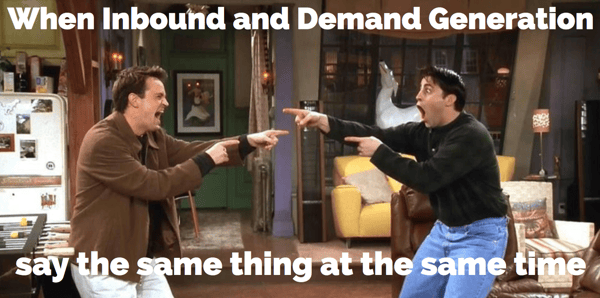
Have you ever played a game of telephone? You know, the childhood game where one person whispers into the ear of another and the information chain continues until the last person repeats the sentence out loud for all to hear. The end product is a jumbled mess that doesn’t even hold the slightest resemblance of what was said in the beginning.
Now, have you ever felt like you were playing a game of telephone with a company whose product interests you? You read a blog or watch a video on their website. Then you speak to a sales rep who provides great service, but the conversation feels completely foreign. Like you’re talking to a completely different company.
That’s why inbound marketing and demand generation are important.
Inbound + Demand Generation
Picture two best friends strolling through the streets. Their innocent, child-like demeanor draws people’s attention and entices them to watch and get excited about their zest for life. The friends never miss a beat and are always on the same page.
Your inbound marketing and demand generation efforts need to act like BFFs. They must go hand-in-hand.
But, How?
In our previous blog post, we explained inbound marketing vs demand generation. Those of you asking, "what is demand generation?," I'll provide a quick refresher. Demand generation is about nurturing relationships with both products and customers. If you have a good number of leads through your demand generation efforts, but none of them are good, qualified leads, what was the point? That’s where inbound comes in. Inbound is a marketing tactic which draws your prospects into your company through informative content. It’s about putting all the pieces together, between your marketing team and your sales team, to assure your puzzle is complete – to assure you’re obtaining quality leads.
Good ways to engage customers are through social media platforms, paid advertising, tradeshows, blog posts, newsletters, and emails. Now, you may be thinking that emails are to engage already existing leads. Yes, but by creating an email and sending it to an audience already engrossed by your product, you can create demand for new content (or products) or re-engage customers who have been inactive for awhile.
What about blogging? If you have a loyal customer who reads your content consistently, and you have created blog posts that reiterate and expand on existing ideas, you may spark a new idea or different perspective your customer has never thought of before. The next step, sharing on social media, engages even more leads and allows existing customers to assist in marketing your business. #SharingisCaring
Why Should You Care?
Marketing today is done across multiple channels. When a customer purchases a product or service, they don’t think about their experience as segmented interactions. They think about the overall experience. Creating a holistic, seamless approach
Inbound marketing and demand generation bridge the gap between a disjunctive marketing and sales process. Focusing your efforts on the long-term and lasting conversations you have with your customers while creating a cohesive buyer experience, will have a permanent impact on your business.
Do you need a best friend? Friend inbound.

